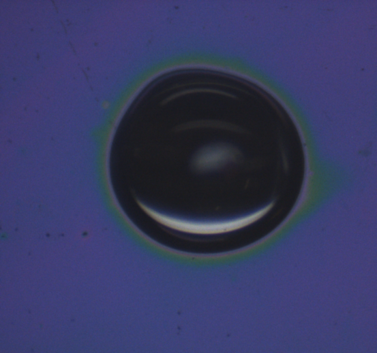
with Emilie Verneuil and Antoine Chateauminois


Wetting dynamics on surface-attached hydrogel thin films
Friction of hydrogel films in water: translation and rotation contact
The exploitation of functional properties of thin films of grafted hydrogels requires a good understanding of their mechanical properties. Hydrogel films are hydrophilic polymer networks containing a lot of water (up to 80-90% by volume), and therefore fragile. The study of hydrogel films under mechanical and frictional stress or in adhesive contacts allows an understanding of the damage mechanisms and the optimization of the stability and durability of the films.
Coatings based on hydrophilic polymers are shown to good candidates to provide anti-fogging functionality. They are likely to delay fogging by absorbing water. We collaborated with Saint-Gobain Research to understand the swelling properties of hydrogel films under humid air flow and the friction properties in a water immersed contact. We determined how the hygroscopy of the polymer as well as the architecture and thickness of the films drive their swelling in a convected humid atmosphere. We also established that the friction of hydrogel films is, in the absence of a lubricating film, driven by water transport within the porous polymer network.

Le développement des propriétés fonctionnelles des films minces d’hydrogels greffés nécessite une bonne compréhension de leurs propriétés mécaniques. Les films d’hydrogels sont des réseaux de polymères hydrophiles contenant beaucoup d’eau (jusqu’à 80-90% en volume), et donc fragiles. L’étude des films d’hydrogels sous contrainte mécanique et de frottement ou dans des contacts adhésifs permet ainsi une compréhension des mécanismes d’endommagement et l’optimisation de la stabilité et durabilité des films.
Les revêtements à base de polymères hydrophiles sont de bons candidats pour apporter une fonctionnalité anti-buée. Ils sont susceptibles de retarder l’apparition de la buée en absorbant l’eau. Nous avons collaboré avec Saint-Gobain Recherche pour comprendre les propriétés de gonflement de films d’hydrogel sous flux d’air humide et les propriétés de frottement dans un contact immergé dans l’eau. Nous avons montré comment l’hygroscopie du polymère ainsi que l’architecture et l’épaisseur des films pilotent leur gonflement en atmosphère humide convectée. Nous avons également établi que le frottement de films d’hydrogel est, en l’absence de film de lubrification, piloté par le transport d’eau au sein du réseau de polymère poreux.

Delavoipière, J.; Tran Y.; Verneuil, E.; Chateauminois, A. Poroelasticity indentation of mechanically confined hydrogel layers. Soft Matter 2016, 12, 8049-8058.
https://doi.org/10.1039/C6SM01448H
Delavoipière, J.; Tran, Y.; Verneuil, E.; Heurtefeu, B.; Hui, C. Y.; Chateauminois, A. Friction of poroelastic contacts with thin hydrogel films. Langmuir 2018, 34, 9617-9626.
https://doi.org/10.1021/acs.langmuir.8b01466
Delavoipière, J.; Heurtefeu, B.; Teisseire, J.; Chateauminois, A.; Tran, Y.; Fermigier, M.; Verneuil, E. Swelling dynamics of surface-attached hydrogel thin films in vapor flows. Langmuir 2018, 34, 15238-15244.
https://doi.org/10.1021/acs.langmuir.8b03206
Ciapa, L.; Delavoipière, J.; Tran, Y.; Verneuil, E.; Chateauminois, A. Transient sliding of thin hydrogel films: the role of poroelasticity. Soft Matter 2020, 16, 6539-6548.
https://doi.org/10.1039/D0SM00641F
Augustine, A.; Veillerot, M.; Gauthier, N.; Zhu, B.; Hui, C.Y.; Tran, Y.; Verneuil, E.; Chateauminois, A. Swelling induced debonding of thin hydrogel films grafted on silicon substrates. Soft Matter 2023, 27, 5169-5178.
https://doi.org/10.1039/D3SM00490B
Ciapa, L.; Olanier, L.; ; Tran, Y.; Fretigny, C.; Chateauminois, A.; Verneuil, E. Friction through molecular adsorption at the sliding interface of hydrogels: theory and experiments. Soft Matter 2024, 30, 5933-5944.
https://doi.org/10.1039/D4SM00313F
Ciapa, L.; Tran, Y.; Fretigny, C.; Chateauminois, A.; Verneuil, E. Molecular adsorption induces normal stresses at frictional interfaces of hydrogels. Soft Matter 2025, 21, 2529-2540.
https://doi.org/10.1039/D4SM01439A
